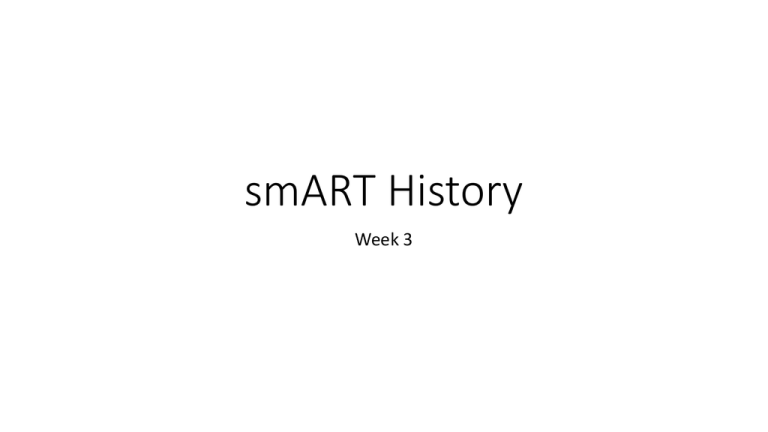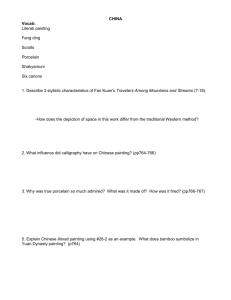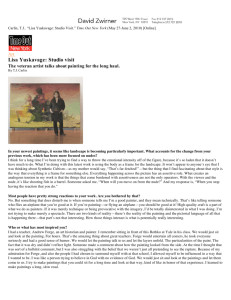smART History Cards Stone Age
advertisement

smART History Week 3 Indian, Chinese, and Japanese (635 BC- 1900 AD) __________________________________________________________ Serene, meditative art, and Arts of the Floating World Chief Artists: Gu Kaishi, Li Cheng, Guo Xi, Hokusai, Hiroshige Silk road opens; Buddhism spreads to China and Japan Glue Examples Here Draw Examples Here Gu Kaizhi (Gù Kǎizhī), known as the founder of traditional Chinese painting, and his scroll paintings, represented the painting style of the period. Nymph of the Luo River survives in three copies dating to the Song dynasty. It illustrates a poem written by Cao Zhi (192-232). http://arts.cultural-china.com/en/77Arts5267.html http://arts.cultural-china.com/chinaWH/upload/upfiles/201011/17/more_info0df45bda45c63ed7a89c.jpg The Admonitions Scroll is one of the most important paintings in the world. It was originally painted by Gu Kaizhi (about AD 345?406), considered to be the father of classical Chinese figure painting. The original painting is now lost, but is known through this close copy made over 200 years later. Throughout history, Chinese artists have sought to emulate Gu Kaizhi's 'gossamer brush line'. This scroll bears the red seals of Chinese emperors and private collectors who once owned the painting. http://www.bbc.co.uk/ahistoryoftheworld/objects/d 8fPFQXIQGyPRBpN6CsPIw The scroll's full title, Admonitions of the Instructress to the Court Ladies, indicates the work's moralising tone. The scroll's protagonist is the court instructress who advises the ladies of the palace on correct behaviour. The poem was originally written around AD 290 to reprimand Empress Jia. She used her influence to manipulate the emperor and murder rivals, during an unstable time in Chinese history known as the Period of Disunion. She ignored the poem's advice, however, and was ultimately forced to commit suicide in a coup in AD 300. BBC A History of the World Gu created more than 70 paintings based on historical stories, Buddha, human figures, birds, animals, mountains and rivers. His three existing scroll paintings include the Nvshi Zhen Painting, Luoshen Appraisal Painting and Lienv Renzhi Painting - the earliest examples of scroll paintings. http://arts.cultural-china.com/en/77Arts5267.html The theme of the Luoshen Appraisal Painting was drawn from the article, Luoshen Appraisal, written by Cao Zhi, son of the Wei Emperor Cao Cao. It depicts the meeting of Cao Zhi and Goddess Luoshen at the Luoshui River. The picture vividly portrays their moods when they first met each other and when they were finally forced to separate. Gu emphasized the expressions of the figures; the stones, mountains and trees in the picture were for ornamental purposes. Early Spring, painted by Guo Xi Three Musicians Pablo Picasso Early 1900s Guo Xi is one of the leading cultural figures from the Song Dynasty period. Born and raised in the Henan province, Xi was a highly educated man, a scholar-official, a theoretician of painting whose essay titled “The Lofty Message of Forest and Streams” influenced many generations of Chinese painters. "Early Spring" is the quintessence of Song Dynasty landscape painting. Xi developed an innovative technique, called "Floating Perspective” or "Angle of the Totality", with which the artist was able to represent multiple perspectives within a single painting. This is an exceptional advance that did not appear in Western painting until many centuries later. Xi was also a meticulous draftsman, which is reflected in the detailed rendering of the trees and the temple located below the small waterfall on the right side of the silk. Although difficult to see at first glance, there are several human figures in the painting, such as the group of travelers going to the temple or the peasants and fishermen on the bottom of the painting. G. Fernández - theartwolf.com Katsushika Hokusai’s Under the Wave off Kanagawa, also called The Great Wave has became one of the most famous works of art in the world—and debatably the most iconic work of Japanese art. Initially, thousands of copies of this print were quickly produced and sold cheaply. Despite the fact that it was created at a time when Japanese trade was heavily restricted, Hokusai’s print displays the influence of Dutch art, and proved to be inspirational for many artists working in Europe later in the nineteenth century. https://www.khanacademy.org/humanities/art-asia/art-japan/edo-period/a/hokusai-under-the-wave-off-kanagawa-the-great-wave "Rainstorm beneath the Summit" 1830-1831 Hokusai Ukiyo-e is the name for Japanese woodblock prints made during the Edo Period. Ukiyo-e, which originated as a Buddhist term, means "floating world" and refers to the impermanence of the world. The earliest prints were made in only black and white, but later, as is evident from Hokusai’s work, additional colors were added. A separate block of wood was used for each color. Each print is made with a final overlay of black line, which helps to break up the flat colors. Ukiyo-e prints are recognizable for their emphasis on line and pure, bright color, as well as their ability to distill form down to the minimum. https://www.khanacademy.org/humanities/art-asia/art-japan/edo-period/a/hokusai-under-the-wave-off-kanagawa-thegreat-wave Lobster and Gray Prawn Hiroshige Utagawa Hiroshige (Japanese: 歌川 広重), also Andō Hiroshige (Japanese: 安藤 広重; 1797 – 12 October 1858) was a Japanese ukiyo-e artist, considered the last great master of that tradition. The Fifty-Three Stations of the Tōkaidō, 1833-34 Kalamkari (Telugu: కలంకారి) or Qalamkari is a type of hand-painted or block-printed cotton textile, produced in parts of India and in Iran. The word is derived from the Persian words ghalam (pen) and kari (craftmanship), meaning drawing with a pen (Ghalamkar). In the early 20th Century, there was a fall in the demand for Kalamkari painted cloth. This century-old-art suffered greatly and the artists took to other professions. By the end of the last century, the art was revived and now there is a huge demand for this. Apart from wall hangings, the artists paint on garments and other household items.







